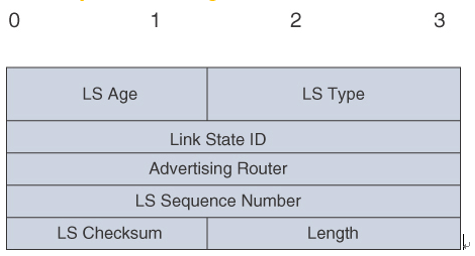OSPFv3 LSAs – OSPF, BGP, and Route Manipulation
OSPFv3 retains the LSA types used by OSPFv2 with some modifications and introduces two new LSAs: link LSA and intra-area-prefix.
All LSAs use a common 20-byte header that indicates the LS type, the advertising router, and the sequence number. Figure 4-8 shows the format of the LSA header.

Figure 4-8 LSA Header
The LS Age field indicates the time in seconds since the LSA was generated.
The LS Type field indicates the function performed by this LSA. This field includes a U bit and S2 and S1 bits. When the U bit is set to 0, the LSA is flooded only locally. When the U bit is set to 1, the LSA is stored and flooded. The S1 and S2 bits have the functions indicated in Table 4-5.
Table 4-5 LSA Header S2 and S1 Bits
| S2 S1 Value | Flooding Scope |
| 00 | Link-local scope |
| 01 | Flood to all routers within the area |
| 10 | Flood to all routers within the autonomous system |
| 11 | Reserved |
The Link State ID field is used with the LS type and advertising router to identify the link-state database. The Advertising Router field contains the 32-bit router ID of the router that generated the LSA. The LS Sequence Number field is used to detect old or duplicate LSAs. The LS Checksum field is for error checking. The Length field indicates the length of the LSA, including the header.
Table 4-6 summarizes the nine LSAs that can be used in OSPF. Most LSAs retain the same function used in OSPFv2 for IPv4. The OSPFv3 LSAs are described in more detail following the table.
Table 4-6 OSPFv3 LSA Types
| LSA Name | LS Type | Description |
| Router LSA | 0x2001 | Specifies the state of a router interface |
| Network LSA | 0x2002 | Generated by DR routers in broadcast or NBMA networks |
| Interarea-prefix LSA | 0x2003 | Routes to prefixes in other areas |
| Interarea-router LSA | 0x2004 | Routes to routers in other areas |
| Autonomous system external LSA | 0x4005 | Routes to networks external to the autonomous system |
| Group-membership LSA | 0x2006 | Routes to networks that contain multicast groups |
| NSSA Type 7 LSA | 0x2007 | Routes to networks external to the autonomous system, injected into the NSSA |
| Link LSA | 0x0008 | Tells neighbors about link-local addresses and lists IPv6 prefixes associated with the link |
| Intra-area-prefix LSA | 0x2009 | Specifies IPv6 prefixes connected to a router, a stub network, or an associated transit network segment |
Router LSAs describe the cost and state of all the originating router’s interfaces. These LSAs are flooded within the area only. Router LSAs are LS type 0x2001. No IPv6 prefixes are contained in router LSAs.
Network LSAs are originated by DRs in broadcast or NBMA networks. They describe all routers attached to the link that are adjacent to the DR. These LSAs are flooded within the area only. The LS type is 0x2002. No IPv6 prefixes are contained in this LSA.
Interarea-prefix LSAs describe routes to IPv6 prefixes that belong to other areas. They are similar to OSPFv2 Type 3 summary LSAs. The interarea-prefix LSA is originated by the ABR and has LS type 0x2003. It is also used to send the default route in stub areas. These LSAs are flooded within the area only.
Each interarea-router LSA describes a route to a router in another area. It is similar to OSPF Type 4 summary LSAs. It is originated by the ABR and has LS type 0x2004. These LSAs are flooded within the area only.
Autonomous system external LSAs describe networks that are external to the autonomous system. These LSAs are originated by ASBRs, have LS type 0x4005, and are flooded to all routers in the autonomous system.
The group-membership LSA describes the directly attached networks that contain members of a multicast group. This LSA is limited to the area and has LS type 0x2006. This LSA is described further in RFC 1584. This LSA is not supported in Cisco IOS software.
Type 7 LSAs describe networks that are external to the autonomous system, but they are flooded to the NSSA only. NSSAs are covered in RFC 1587. This LSA is generated by the NSSA ASBR and has type 0x2007.
Link LSAs describe the router’s link-local address and a list of IPv6 prefixes associated with the link. This LSA is flooded to the local link only and has type 0x0008.
The intra-area-prefix LSA is a new LSA type that is used to advertise IPv6 prefixes associated with a router, a stub network, or an associated transit network segment. This LSA contains information that used to be part of the router LSAs and network LSAs.
